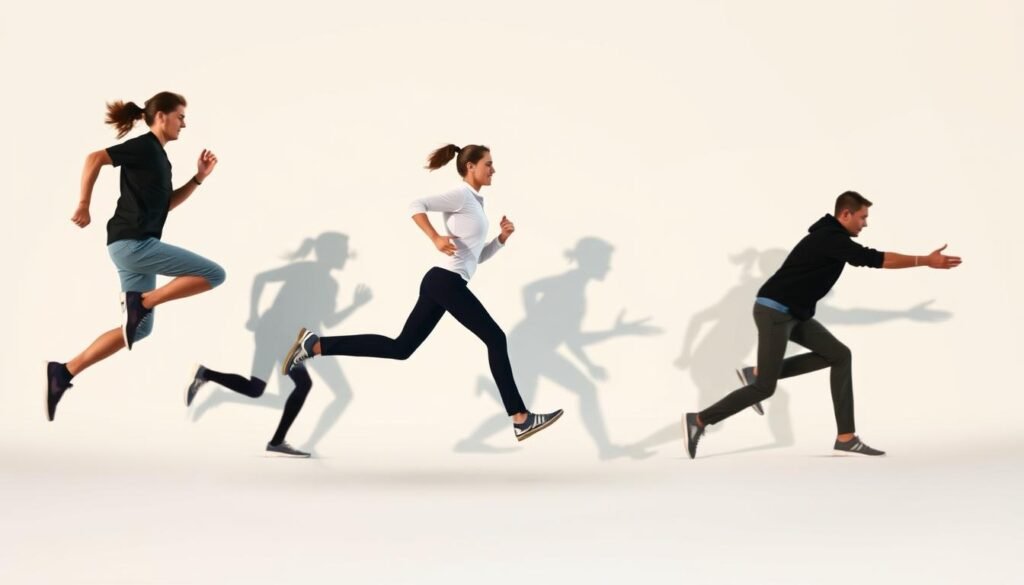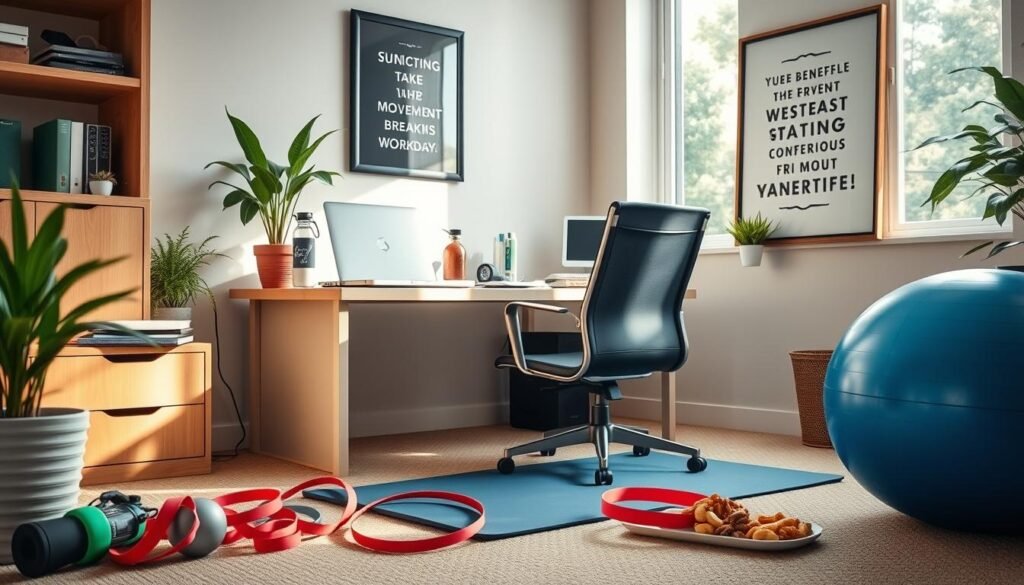Did you know that just a few minutes of physical activity can boost your focus and energy levels? In today’s busy world, finding time for exercise can feel impossible. But what if you could integrate small bursts of activity into your daily routine?
Enter movement snacks—short, 1-3 minute activity breaks designed to fit seamlessly into your schedule. These micro-movements are backed by research, including insights from Hinge Health, which found a 68% reduction in pain with consistent use. Whether it’s a quick stretch or a brief walk, these small actions can make a big difference.
Studies, like one published in Nature Medicine, show that even vigorous micro-activities can reduce mortality risks. Plus, they’re perfect for the workplace—think deskercises or walking meetings. By stacking these activities throughout the day, you’ll not only improve your health but also enhance your mental clarity.
Ready to learn how to make movement snacks a part of your routine? Let’s dive in!
Key Takeaways
- Movement snacks are 1-3 minute activity breaks that fit into busy schedules.
- They improve mental clarity and reduce pain, as shown by Hinge Health research.
- Micro-movements can lower mortality risks, according to studies like Nature Medicine.
- These activities are ideal for workplaces, including deskercises and walking meetings.
- Consistent use of movement snacks supports long-term musculoskeletal health.
What Are Movement Snacks?
Ever wondered how small activity breaks can transform your day? Dr. Peterson describes them as an “appetite for movement between workout meals.” These short bursts of activity are designed to fit seamlessly into your routine, offering a practical way to stay active without disrupting your schedule.
Unlike traditional exercise, which often requires equipment or a dedicated time slot, movement snacks are quick and simple. They restore blood flow, activate synovial fluid in your joints, and counteract the negative effects of prolonged sitting. A 2022 study in Nature Medicine found that even brief vigorous activity can lower mortality risk by 40%.
Why Movement Snacks Matter
Our bodies thrive on movement, but modern lifestyles often keep us sedentary for hours. This can lead to muscle atrophy, poor circulation, and joint stiffness. Hinge Health data shows that hourly micro-stretches can reduce joint pain and improve flexibility. By incorporating these small breaks, we can enhance our overall health and well-being.
How They Counteract Sedentary Lifestyles
Movement snacks are a powerful tool to combat the risks of sitting all day. They help maintain muscle tone, improve circulation, and reduce discomfort. For example, a case study from Hinge Health revealed that frequent position changes significantly reduced lower back pain. Additionally, workplace studies show that 5-minute hourly breaks can boost productivity by 12%.
From chair yoga to power vacuuming, these activities span a wide spectrum. They’re not just about fitness—they’re about creating a healthier, more balanced day. By stacking these small actions, we can build a sustainable habit that supports both our physical and mental health.
Benefits of Incorporating Movement Snacks
Integrating short activity breaks into your day offers surprising benefits. These bursts of activity not only improve your physical health but also enhance your mental well-being. Let’s explore how these small changes can make a big impact.
Improved Energy and Focus
Short activity breaks can boost your energy levels and sharpen your focus. A 2018 study by Edwards & Loprinzi found that just 30 seconds of activity improves cognitive performance. This means faster decision-making and better productivity throughout the day.
Enhanced Cardiovascular Health
Even brief vigorous activity can benefit your heart. Research by Stamatakis et al. (2022) shows that 1-minute bursts reduce cardiovascular disease risk by 54%. Activities like stair climbing or desk push-ups can mimic the effects of HIIT workouts, improving your overall fitness.
Better Flexibility and Joint Mobility
Regular stretching and yoga breaks can enhance flexibility and joint mobility. A study by LiveLighter found that office workers who practiced yoga improved their range of motion by 23%. Simple seated thoracic rotations can also correct posture and reduce discomfort.
Reduced Stress and Anxiety
Activity breaks are a natural way to lower stress and anxiety. Diaphragmatic breathing during stretches reduces cortisol levels, promoting relaxation. Hinge Health’s app users reported significant anxiety reduction after incorporating these breaks into their routines.
By stacking these small actions, you can create a healthier, more balanced day. Whether it’s a quick stretch or a brief walk, these movement snacks support both your physical and mental health.
Practical Ways to Add Movement Snacks to Your Day
Looking for simple ways to stay active during a busy day? Incorporating short bursts of activity into your routine can make a big difference. These small actions, known as movement snacks, are easy to fit into your schedule and can boost your energy and focus.
Deskercises: Quick Exercises at Your Workspace
Your desk doesn’t have to be a barrier to staying active. Try glute squeezes during Zoom calls or seated leg lifts. Tools like Hinge Health’s under-desk pedal exerciser can turn idle moments into productive workouts.
Active Breaks: Replacing Idle Time with Movement
Swap sitting for walking or climbing stairs during breaks. Even a 3-minute walk can refresh your mind and body. The 7-7-7 method—7 squats, 7 push-ups, and 7 lunges hourly—is another great way to stay active.
Stretching and Yoga for Relaxation
Incorporate stretching or yoga into your day to improve flexibility and reduce stress. Simple seated stretches or chair yoga can help counteract the effects of prolonged sitting. These activities also promote better posture and balance.
Everyday Activities Turned into Movement Opportunities
Turn chores into activities that keep you moving. Power vacuuming burns 150 calories per hour, and calf raises while brushing your teeth can strengthen your body. These small changes add up, helping you stay active throughout the day.
By integrating these practical tips, you can create a healthier, more balanced routine. Start small, and soon these short bursts of activity will become a natural part of your day.
Conclusion
Small steps can lead to big changes in your daily life. Incorporating short bursts of physical activity into your routine can improve both your health and well-being. Research from Hinge Health shows that consistent use of these micro-breaks can reduce pain by up to 68% over 12 weeks, making them accessible even for chronic pain sufferers.
These small actions are more than just a quick fix—they’re a gateway to building a sustainable fitness routine. Whether it’s a stretch or a brief walk, every movement counts. Hinge Health’s free employer-covered programs make it easy to get started, offering tools to help you reclaim your body autonomy.
We walk this path together, supporting each other in creating healthier habits. Download our movement snack planner PDF to start today. Remember, every step you take is a step toward a healthier, more balanced day.
FAQ
What exactly are movement snacks?
Movement snacks are short bursts of physical activity you can do throughout your day. They’re designed to break up long periods of sitting and help you stay active without needing a full workout.
Why should I add movement snacks to my routine?
Incorporating these small activities can boost your energy levels, improve focus, and reduce the risks associated with a sedentary lifestyle, like heart issues or muscle stiffness.
How do movement snacks improve my health?
They enhance cardiovascular health, increase flexibility, and reduce stress. Even a few minutes of stretching or walking can make a big difference in how your body feels.
Can I do movement snacks at my desk?
Absolutely! Deskercises like chair squats, seated leg lifts, or shoulder rolls are perfect for staying active while working. These simple exercises can help improve posture and keep your body engaged.
What are some easy ways to start with movement snacks?
Start by taking short breaks to walk, stretch, or climb stairs. You can also turn everyday tasks, like standing while on a call or doing light yoga, into opportunities to move more.
How often should I do movement snacks?
Aim for a few short bursts of activity every hour. Even 1-2 minutes of movement can help improve your energy levels and keep you focused throughout the day.








